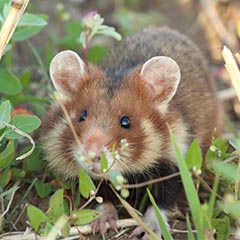A Disappearing Keystone Species
The European hamster (Cricetus cricetus) is the world’s largest hamster – closer in size to a guinea pig than the golden hamster found in pet stores. It was once a common and important keystone species of Central Europe’s grassland steppe region – in fact one of its names was ‘common hamster’ – but habitat loss (primarily from agricultural expansion) has led to its rapid disappearance across much of its once-vast range, and it is now listed as Critically Endangered by IUCN.
Prior to the Russian invasion of Ukraine, the Center for Breeding and Conservation of Endangered Species at the Kyiv Zoo in Ukraine was running a project on the captive breeding and reintroduction of European hamsters. Prior to the war a survey indicated a population decline within Odessa Province of 90% in the active hamster population from 2017 to 2021. These populations are now the only ones left from this lineage.
War and Hamsters
Due to the Russian invasion of Ukraine, the breeding season in 2022 was missed, leaving an aging population of hamsters in the breeding colony. In addition, a partner in the project was unable to continue participating. However, a new on-the-ground partner has now been found.
Zoo New England Helps Out
ZNE is now providing funding to help the consortium find the remaining hamsters of this lineage before they finally go extinct, take them to the breeding center for captive breeding, and release the progeny back to the wild for reintroduction and re-establishment of sustainable populations of this important steppe species.
Zoo New England is also providing funding through a grant from the Trust for Mutual Understanding to bring the three key Ukrainian conservation scientists working on the hamster to the San Diego Wildlife Alliance (part of the San Diego Zoo). The Wildlife Alliance has staff who are global experts in captive breeding and reintroduction of small mammals, and the Ukrainians will work side-by-side with their Californian counterparts for two weeks to learn best practice techniques to help them improve their work to recover the Critically Endangered European hamster.
Photos courtesy of Kyiv Zoo



